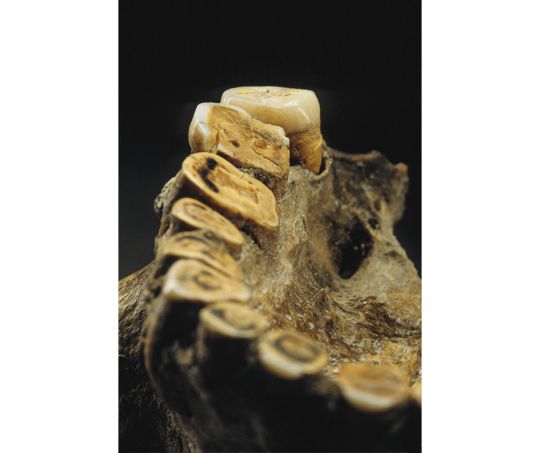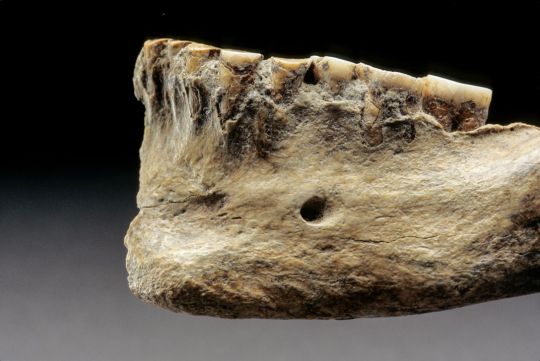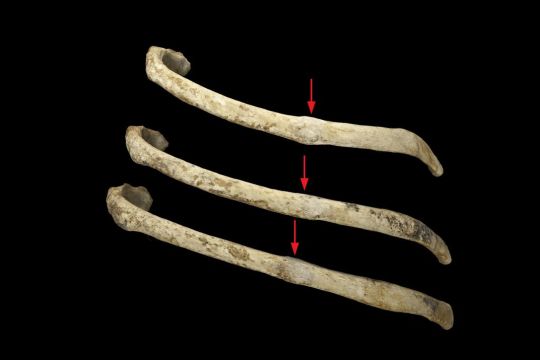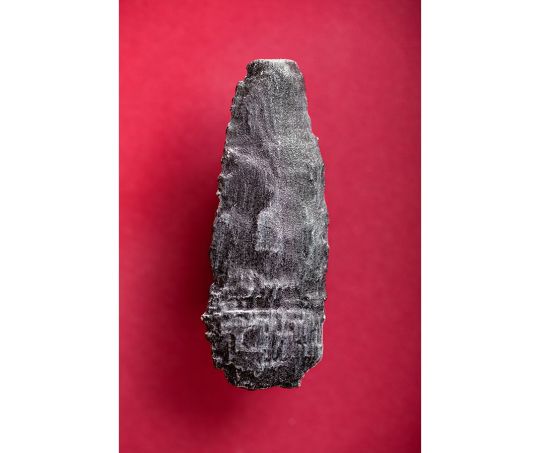Text
My Statement
I have created this blog (thekennewickman.tumblr.com) as my final project for Anthropology 41: Human Evolution. My blog mainly consists of a timeline titled “Saga of the ‘Ancient One.’” I have shared three additional posts to the site to provide more information for anyone’s that is interested in learning more. The other posts are: Bonnichsen v. US Case Briefs, images of the remains from Smithsonian Magazine, and this statement. I have also added two other pages (accesible via the Menu) to the site that include the following: (1) sources (they are also individually linked throughout the timeline and the other posts) used to create the timeline, (2) videos I found useful and interesting during the process of gathering information for this project.
I originally wanted to write an Op-Ed-esque research paper, but after reading through the suggestions creating an educational website seemed like a much better idea. I believe that in the “Age of Misinformation” we live in, the best way to combat the spread of misinformation is to make a strong and active effort to share correct information that is easily accessible and readily available to anyone. I wanted to create a website that would remain on the Internet after this term that maybe would come up in a handful of Google searches for others in the future. For me, that would be incredible--if I could help others educate themselves and in this case, help others understand how important it is in any science to consider the ethical implications and how necessary it is to earn the trust of the communities your studying to be able to work together and as Colwell, puts it “demonstrate how scientific practices can be respectfully applied for mutual benefit.”
I chose to explore the Ancient One’s case after he was briefly mentioned in our Human Evolution class. I began thinking about the myriad of ethical implications this situation had for all the parties involved and I needed to learn more. After reading many articles on the Kennewick Man’s discovery and the following legal battle, I was very glad that the repatriation demands on behalf of the Native Americans continued until he was returned to his people. In other words, the fact that they did not yield their rights against all odds was incredible.
It is difficult to determine where we draw the line, when is it an archaeological discovery and when is it grave robbing? Although it is undoubtedly very complex to determine, it is important for the parties involved to communicate respectfully and cooperate as needed. Sounds simple, right? I agree, in theory. However, let’s be real. This was battle between the government and a historically oppressed population, Native Americans, that literally had a LAW (Native American Graves Protection and Repatriation, NAGPRA) created in to prevent precisely this in an attempt to make reparations, but the government still got their way and satisfied their scientific curiosity.
This issues goes beyond religion versus science. Religious beliefs are not usually only the reason remains are protected, it is a matter of justice and agency. Native Americans have been and continue to be exploited in the United States of America. Their wishes must carry a greater weight than the curiosity of the scientific community. This is an issue of our own humanity and it should be treated with the decency, integrity, and the respect it requires.
I hope the timeline I created and the resources published on this website will allow you to reach your own conclusions, but more importantly that they make you think critically about the events that transpired like they made me.
-S.
0 notes
Photo










Preston, Douglas. “The Kennewick Man Finally Freed to Share his Secrets” Smithsonian Magazine, September 2014. https://www.smithsonianmag.com/history/kennewick-man-finally-freed-share-his-secrets-180952462/
0 notes
Text
Bonnichsen v. US Case Briefs
Here’s the two case briefs for the Bonnichsen v. US for anyone that is interested in reading more about the legal battle for the Ancient One’s remains. Check out the timeline for more details.
1. United States District Court, D. Oregon (2002)
2. United States Court of Appeals, Ninth Circuit (2004)
*Note: I have shared these documents via Google Docs since Tumblr doesn’t host PDFs. The link will take you to a Google Docs link out of the blog.
0 notes
Text
Saga of the “Ancient One”
1990 - Native American Graves Protection and Repatriation Act (NAGPRA) is passed by President George W. Bush.
July 1996 - Two college students Will Thomas and Dave Deacy found the Kennewick Man, referred to as the Ancient One by Native American tribes, skull along the shore of the Columbia River in Washington state, USA. They call the police and Benton County coroner, Floyd Johnson arrives at the scene. He does not know what to do with the findings and he calls local archaeologist, James Chatters.
Approximately 300 bones and bone fragments dated to 8,340-9,200 years ago were found belonging to the the Ancient One, “the oldest and best-preserved sets of remains ever discovered in North America.” These bones made up “~90% of an adult male skeleton.”
Chatter sent a bone sample for it to be carbon dated and that is when the Army Corps of Engineers (managed the land where the bones were found) not only claimed the authority of the remains, but also “demanded all scientific study cease.”
They proved their jurisdiction over the remains and they were “locked up at the Department of Energy’s Pacific Northwest National Laboratory.”
Native American tribes said the bones belonged to an ancestor and quickly moved to reclaim the remains and provide a “ritual burial.”
Armand Minthorn, a spokesman for the Umatilla tribe, wrote, “Scientists have dug up and studied Native Americans for decades. [...] We view this practice as desecration of the body and a violation of our most deeply-held religious beliefs.”
In response, the corps agreed to return the bones to the Native American tribe. However, scientists did not agree with this. Owsley contacted members of Congress and the corps and said that “the remains should be studied, if only briefly before reburial.”
Researchers lead by Owsley filed a lawsuit (eight plaintiffs) against the Native Americans claim because according to them, the Kennewick Man “could not be linked to living Native Americans” and in fact, needed to be study to show an affiliation to a modern tribe. NAGPRA did not apply.

1998 - Authorities recognize that “substantial parts of the femur bones” had disappeared in the move to the Department of Energy’s Pacific Northwest Laboratory.
2000 - Then-Secretary of the Interior Bruce Babbitt concluded that the Ancient One’s remains belonged to the tribe and ordered they be returned.
2001 - The femur bones of the Kennewick are found this year in the evidence vault of the county coroner’s office.
2002 - U.S. Magistrate John Jelderks in the United States District Court of Oregon ruled the remains of the Ancient One were not related to Native Americans “based on its physical features, and therefore the NAGPRA didn’t apply in this case.” The remains were sent back to the researchers and the decision was upheld in the court of appeals.
The motion was granted and the District Court specifically held (Bonnichen v. U.S. - 217 F.Supp.2d 1116):
“(1) remains of Kennewick Man were not Native American within meaning of Native American Graves Protection and Repatriation Act (NAGPRA);
(2) Secretary of the Interior erred in assuming that coalition of four federally recognized Indian tribes and a band that was not federally recognized was a proper claimant under NAGPRA and in failing to separately analyze the relationship of the particular tribal claimants to the remains;
(3) evidence did not support determination that there was a “cultural affiliation” between remains and tribal claimants; and (4) plaintiffs would be permitted to study the remains.”

2004 - The United States Court of Appeals of the Ninth Circuit rules in favor of the scientists, citing research that demonstrated the Kennewick Man was not Native American. Native Americans tribes appealed, the Court of Appeals affirmed the decision and tribes moved for rehearing.
The court specifically held the following (Bonnichsen v. U.S. - 367 F.3d 864):
“(1) scientists had standing to bring action;
(2) human remains must bear some relationship to presently existing tribe, people, or culture to be “Native American” within meaning of NAGPRA; and
(3) substantial evidence did not support Department's decision that remains were Native American within meaning of NAGPRA.”
2005 - Research on the Kennewick Man continued this year, following eight years of legal battles preventing the repatriation of his remains to Native Americans.
The research group was led by Douglas W. Owsley, the division head of physical anthropology at the Smithsonian received permission to study the bones discovered.
These are some of discoveries his team made:
“He was a stocky, muscular man about 5 feet 7 inches tall, weighing about 160 pounds.”
Right-handed
Looked a lot like “baseball pitcher’s;” he threw a spear
Left left was much stronger than the right one, must have “arrested [his] forward momentum” with this leg
Hands and forearms show he “often pinched his fingers and thumb together while tightly gripping a small object”
Leg bones suggest he swam in shallow rapids and they reported he had “been growth consistent with surfer’s ear”
Knee joints show he must have “squatted on his heels” often
Years before his death, he had broken half a dozen ribs
five broken ribs never healed properly since he continued throwing spears with his right arm
Two small depression fractures on his cranium
Spearpoint was thrown at him and it injured and embedded itself in his hip when he was 15-20 years old
Others must have taken care of him because his injury healed and his limp disappeared over time
Ate “almost exclusively on seals, sea lions, and fish”
Drank glacial meltwater
Died at around 40 years of age
2014 - “Kennewick Man: The Scientific Investigation of an Ancient American Skeleton” edited by Douglas W. Owsley and Richard L. Jantz is published in September of this year. It is regarded as “the most complete analysis of a Paleo-American skeleton ever done.” His remain were in storage at the Burke Museum at this time.
2015 - Geneticists at the University of Copenhagen in a collaborative study with Stanford University’s Medical Center published an article in the journal Nature that demonstrated that the Native American tribes had been right all along. The senior author of the study Eske Willerslev, PhD, said, “It’s very clear that Kennewick Man is most closely related to contemporary Native Americans.” He added, “In my view, it’s bone-solid.” The study found that based on genetic comparisons, the Kennewick man “shows continuity with Native North Americans over at least the last eight millennia.”

Stanford University released a statement on June 18, 2015 with more information of their findings, disproving claims made in a 2014 study that said the Kennewick Man was “more related to indigenous Japanese or Polynesian peoples than to Native Americans.”

2016 - President Barack Obama signed the Water Infrastructure Improvements for the Nation Act (WIIN Act), which included a section that transferred the control of The Ancient One to five Native American tribes.
2017 - The tribes reburied the Ancient One “in a grave not far from where he was found along the Columbia River.”

1 note
·
View note